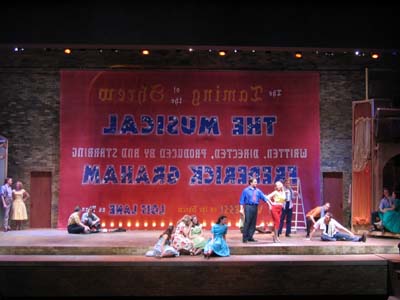
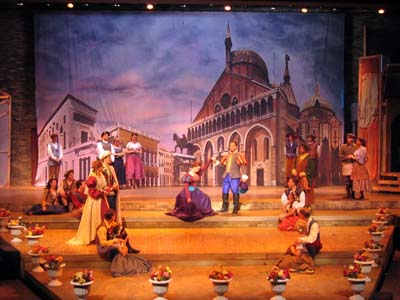
The
University of Minnesota Duluth
Department of Theatre
presents
Kiss Me, Kate
Music and lyrics by Cole Porter
Book by Sam and Bella Spewack
Directed by Kate Ufema
Scenic Design by Roger Hanna
Costume Design by Sarah Bahr
Lighting Design by Mark Harvey
October 20-29, 2005
Lighting Design Approach
The lighting design approach for this production began with the premise that back stage scenes and on stage scenes for Taming of the Screw, the Musical would be differentiated by color. I wanted backstage scenes to appear cooler and more shadowy than scenes when the company was presenting the musical.
 |
 |
Back stage scene for Kiss Me, Kate |
Front of house scene from Taming of the Screw, the Musical as played within Kiss Me, Kate |
This approach required double hanging those areas of the stage that were used as both back stage space and on stage space. The thrust stage, divided by two hydraulic lifts, were used as Fred and Lilli's dressing rooms until the final scene.
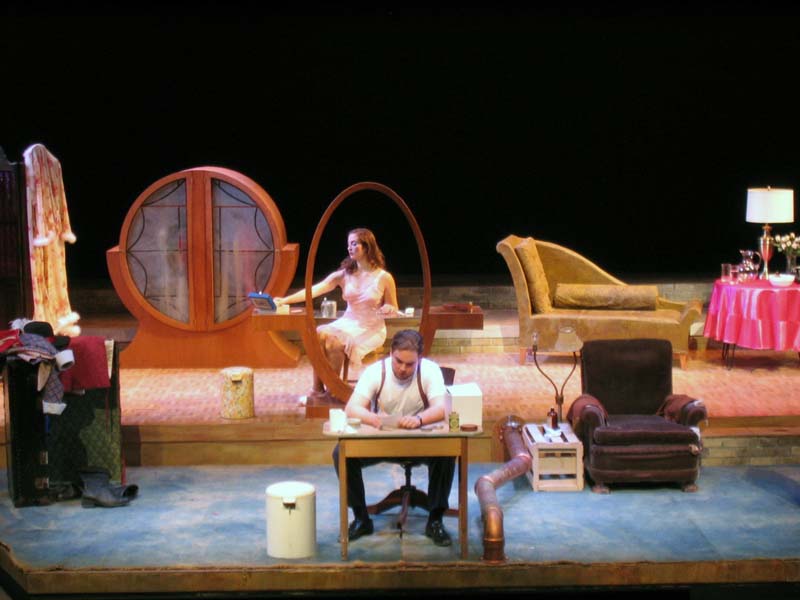 |
Fred's dressing room down stage. Lilli's dressing room immediately behind. |
Early on we were faced with the conceptual dilemma posed from the number "Too Darn Hot" which is set back stage. It's a hot dance number located in a space we deemed to be cooler in contrast to on stage scenes. Our decision was to begin the song in the comparatively realistic back stage light, but then gradually shift to warmer colors as the dance progressed. This number needed to have side light to accentuate the dance. Since all Shrew scenery was stored in the wings, it was necessary to create some high side light positions to get side light over the top of the scenery. I created three lanes of side light with four initial colors per lane from each side. For visual interest, a slowly swirling image of red fire was projected on the drop and back stage wall.
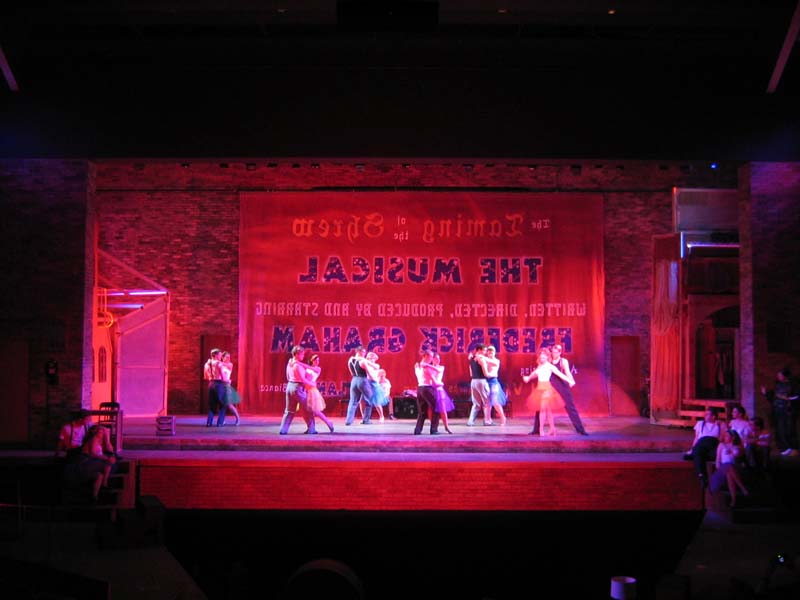 |
"Too Darn Hot" |
The lighting design for Kiss Me, Kate was modified a great deal due to excellent ideas from the director and scenic designer. I was unaware of an added night scene to Petruchio's house, so the three color wash on the Padua drop was altered. We kept the light blue and cyan colors originally planned for the cyc, but replaced the warm wash with a deep blue. Mixing the three sets of blue together gave the show several more options when creating the appearance of different times of day.
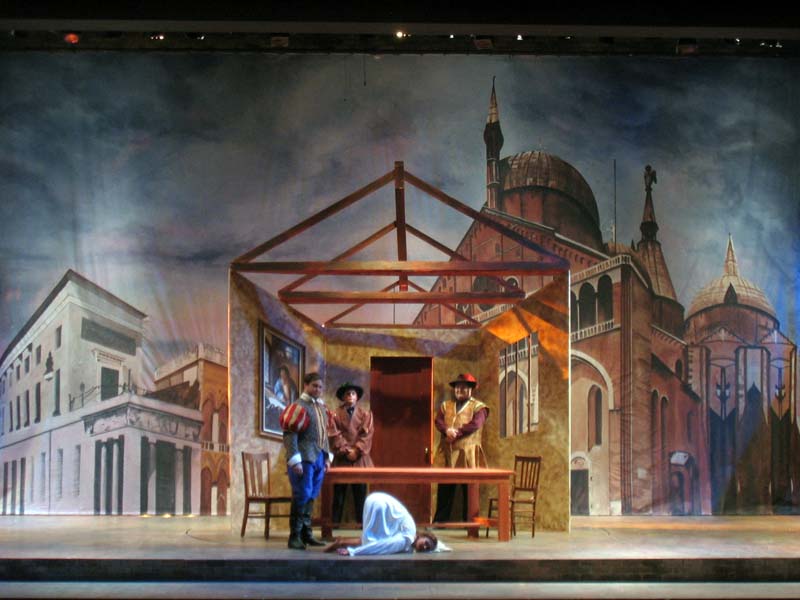 |
Night scene in Petruchio's house |
I initially planned not to have any light fixtures on the balcony rail due to the video monitors set up for the cast. We already had some sight line problems with the video monitors, and I felt adding lights on the balcony rail would not be necessary. During tech week, however, it became evident that lights from the balcony rail would be required, particularly in the Shrew scenes. I chose a position on the rail further from center than normal in order to get the low lighting angle we needed without obscuring our audience's view of the stage.
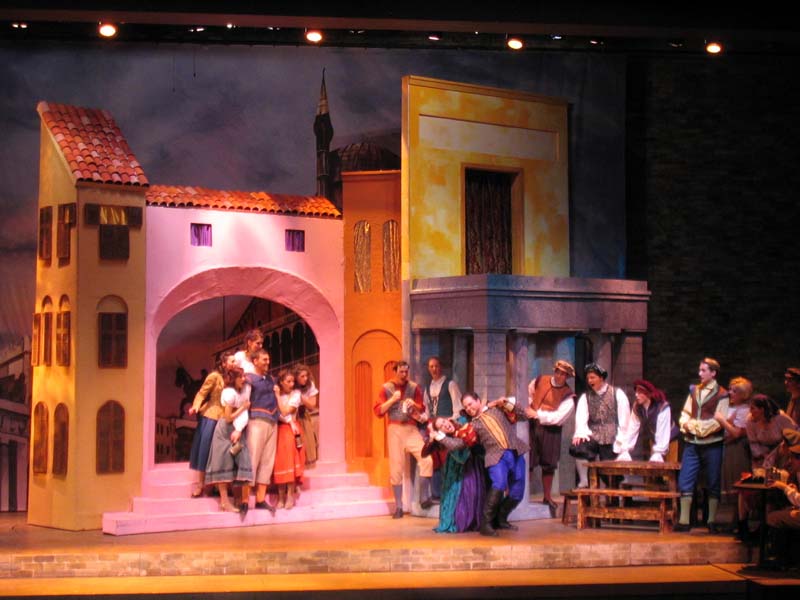 |
Finale Act One "Kiss Me. Kate" |
In "Two Darn Hot", the red side light was working well, but the overall look was too dark. We added a circuit of red light from the down stage up lights and that helped fill in shadows, but we also needed some white edge to help define the dancers on stage. I went back to three sets of high dark blue side lights I'd originally planned for the scene shift scenes into The Taming of the Shrew, the Musical, and changed one set from either side from dark blue to a lighter blue. Adding this light blue side light to the dance during "Too Darn Hot" created the white edge look I was hoping for.
 |
"Too Darn Hot" |
Scenery for Taming the Shrew, the Musical were large blocks of pastel, Tuscany-like colors. I responded to the rather splotchy lighting I was getting on the sets in two ways. First, I put frost in all the ellipsoidals, thus reducing as many edges in the spot lights as possible. Second, I committed one set of side light specifically to the scenery. From stage right I added a group of leaf gobos, and from stage left we swapped out the amber gel for a cool fill light. I also changed all the amber side light from a deep straw to a more peachy color to better flatter the costumes and performers' skin.
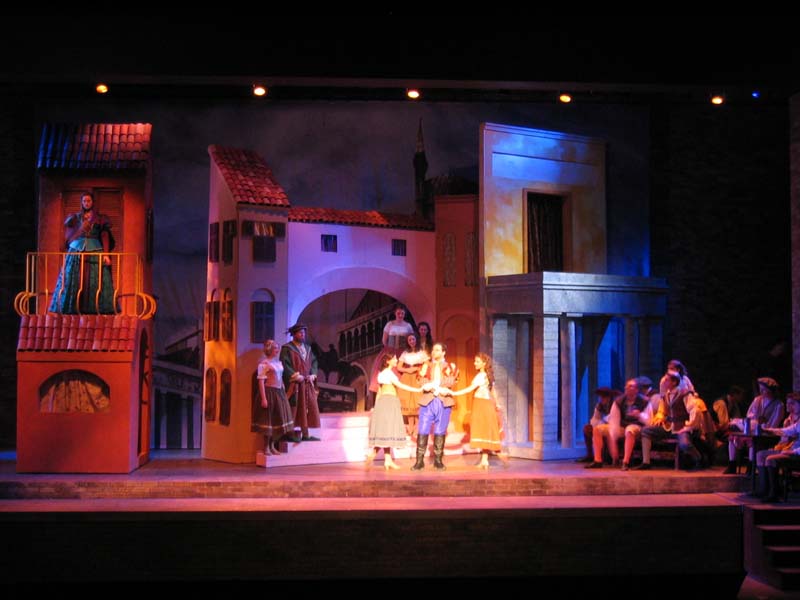 |
"Were Thine That Special Face" |
The lighting for the back stage space was enhanced in several ways as well. The false proscenium located far upstage was gilded, so we added two fresnel specials to the footlights to make the proscenium stand out more. The telephone special was altered several ways. It grew to include the door, and was softened in order to not show harsh shutter lines on the brick wall behind. The color was adjusted to a more neutral warm color. The doorman special was added at the director's request. A simple down light helped him stand out at his desk area. Another suggestion from the scenic designer was to add some kind of breakup on the brick wall so it didn't look quite so new. The step units going into the house were important acting areas, so specials were added to highlight these specific areas. The cool top light over the proscenium part of the stage was lightened because the dark blue color originally chosen was too saturated.
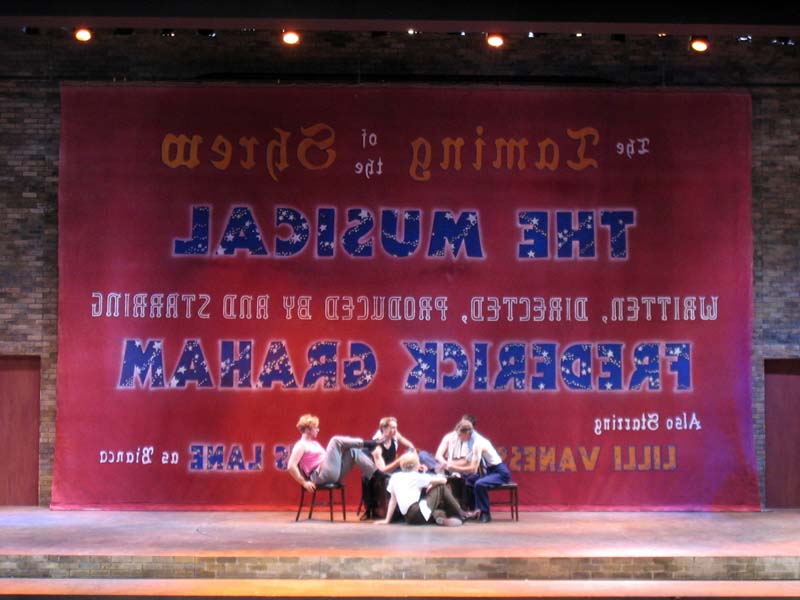 |
Top of Act Two |
Another suggestion from the scenic designer was to include a source of up light for the scene when the two gangsters are caught back stage. The scenic designer had a special drop created for this scene which had the appearance of an asbestos drop with the slogan "Asbestos is Your Friend" painted on it. The up light created a new look for the stage, which is usually difficult to accomplish this late in a musical. We added specials to highlight the words painted on the drop, and ended up borrowing two follow spots, the brightest available within the city limits, in order to get as much punch as possible.
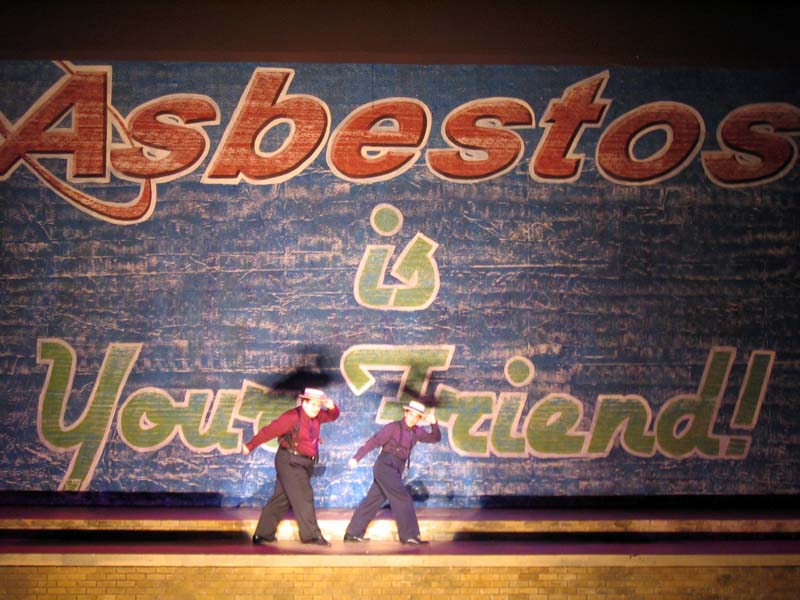 |
"Brush Up Your Shakespeare" |
Transition between scenes was critical to the success of Kiss Me, Kate. As the dressing rooms rose on hydraulic lifts on the down stage portion of the stage, scenery needed to be shifted up stage. We accomplished this in two ways. In some scenes, particularly when we were moving into Shrew scenes, we deliberately allowed the audience to see the shift crew move scenery into place. The scenery was placed facing upstage as if the audience for Taming of the Shrew, the Musical was beyond the back wall of the theatre. The center portion of the scenery was then turned on a revolve to face downstage. Scenic units left and right were turned by the crew.
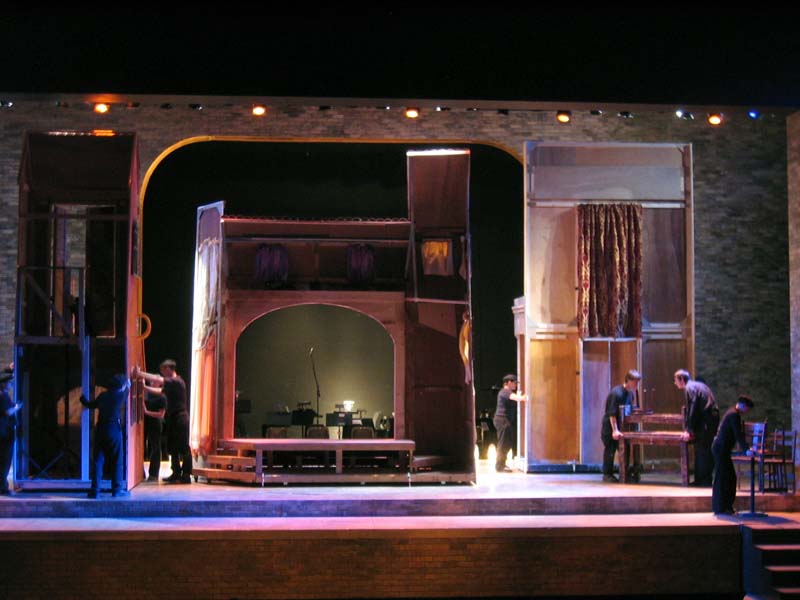 |
Shift into Taming of the Shrew, the Musical in full view of the audience. |
When shifting out of Shrew scenes, we usually brought in a black scrim to minimize the view of shifting scenery. The apron of the stage between the thrust and the black scrim which hung just upstage of the proscenium became an important transitional acting area and was lit in a variety of ways to add visual interest to different scenes played there.
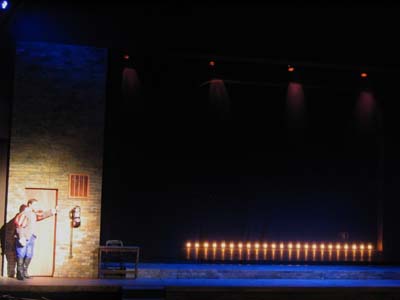 |
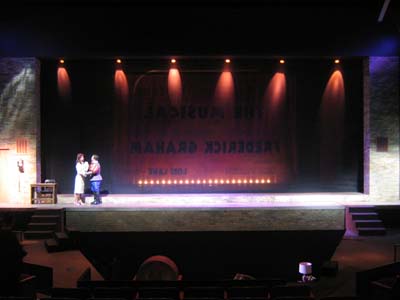 |
Fred sings "So In Love". |
Fred attempts to keep Lilli from leaving the theatre. |
| Production Team | Production Crew |
Review
Kiss Me, Kate Features Great Performances
by Paul Brissett
for the Duluth News Tribune
Any competent performance of Kiss Me, Kate would be a joy, if only for Cole Porter's songs and William Shakespeare's dialogue, but in UMD Theatre's current production, you also get Ben Elledge's smashing performance as Fred/Petruchio as well as a generous portion of other delightful, if less overwhelming, treats.
Elledge has had an impact on virtually every production in which he's been cast during his career at UMD, but in this, his final year, he has surpassed all previous turns. He sings magnificently, in a range of styles and moods from "Wunderbar" to "So In Love" and displays a keen comic sense. Elledge is totally convincing as the character, whether the scene calls for rage or tenderness, humor or poignancy. But more than anything it is his sheer presence that gives this production its special spark.
Fred is half of a couple in a theater company staging Shakespeare's The Taming of the Shrew far off Broadway. His antipathy toward his ex-wife Lilli (Stacia McKee), who plays Kate, spills over into their onstage interactions until she threatens to leave mid-show. This Fred cannot tolerate, because he needs the show to continue running so he can pay a gambling debt.
Director Kate Ufema and scenic designer Roger Hanna have devised an ingenious way to give the audience an optimal view of both backstage and onstage happenings. The key is a large section of the set that rotates when the curtain "rises" on the "Shrew," then reverses when it "falls."
But the show offers more than Elledge and ingenuity. McKee is possessed of a voice equal to the demands of Puccini or Verdi, which she applies with warmth and naturalness to "So In Love" and with fire and humor to "I Hate Men." Her acting, unfortunately, suffers from proximity to Elledge's performance. Although all the pieces are there, her character's strong but confused feelings toward Fred lack conviction.
On the other hand, as Lois/Bianca, Sarah Schmitz's feelings radiate throughout the Marshall Performing Arts Center theater, portraying the passions and anxieties of an ambitious young actress in love with a badly flawed man. What's more, she has a great singing voice and dances with style and flair.
The show is choreographed by UMD alum Darci Brown Wutz, who has integrated dance majors with acting majors so effectively that it's imperceptible. Her crowning achievement in this production is a sizzling "Too Darn Hot," centered on an over-the-top Paul (Dan Travis), to open Act II.
Another highlight of Act II -- in fact, nearly a show-stopper -- was Bryan Maus' and Zach Pizza's "Brush Up Your Shakespeare." The pair, as classic old-fashioned gangsters in dark, double-breasted suits and wide-brimmed fedoras, suddenly find themselves onstage in the harsh glare of the spotlights. At first reluctantly and tentatively, but then with growing confidence and zeal, they go into a song-and-dance routine that had the Thursday night audience whooping and whistling.
Thursday's performance included an unusually large -- for a UMD production -- number of opening night glitches: technical miscues and fumbled lyrics, mostly. Not enough to spoil anyone's enjoyment, but more than we're accustomed to seeing at UMD.
Something to which we have become accustomed: A performer usually only gets one star role in a season, which means this could be your last chance to see Elledge locally. Don't miss it.